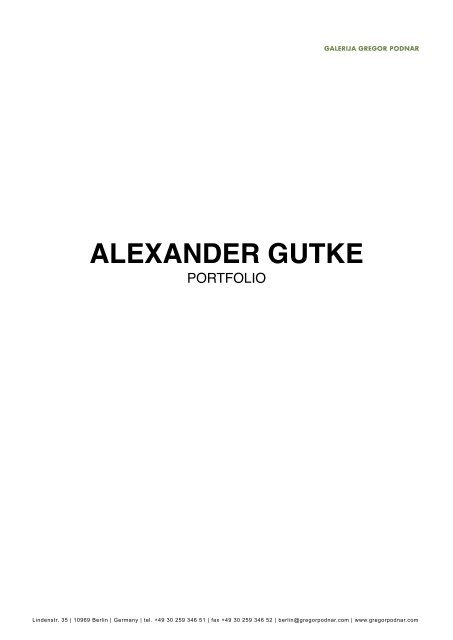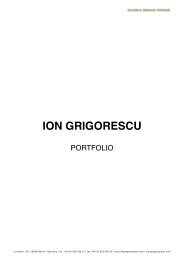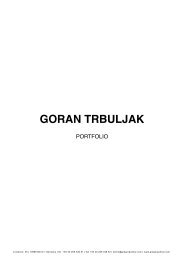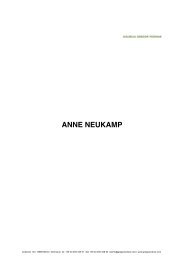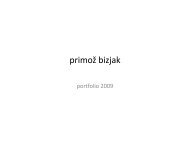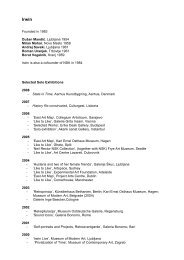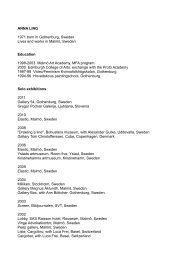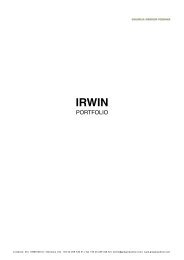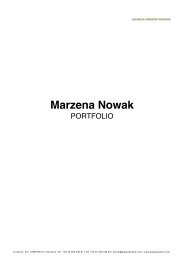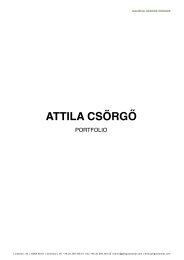ALEXANDER GUTKE - Galerija Gregor Podnar.
ALEXANDER GUTKE - Galerija Gregor Podnar.
ALEXANDER GUTKE - Galerija Gregor Podnar.
Create successful ePaper yourself
Turn your PDF publications into a flip-book with our unique Google optimized e-Paper software.
<strong>ALEXANDER</strong> <strong>GUTKE</strong><br />
PORTFOLIO<br />
Lindenstr. 35 | 10969 Berlin | Germany | tel. +49 30 259 346 51 | fax +49 30 259 346 52 | berlin@gregorpodnar.com | www.gregorpodnar.com<br />
!
Measure<br />
Laser engraved brass Moebius strip, 69 x 14 x 3 cm, ed. 5 + AP, 2011<br />
A wall hung sculpture made from sheet brass, which has been twisted and turned into the shape of a moebius strip.<br />
The sheet brass has been laser engraved with markings indicating millimeters and centimeters and bent into a<br />
shape similar to a flexible tape measure.<br />
!
17 Dagar (Stormgatan 4)<br />
C print, 70 x 70 cm unframed, ed. 3 + AP, 2011<br />
The first step of the final photographic work is a photograph of the artist's white studio wall. Once this photograph is<br />
printed, it is photographed again, hung on the same wall, at the same time (approximately same light) the day after.<br />
This step is repeated 17 times. The blue color appeared form the saturation, due to the repetition, of a tiny cold<br />
tone from the studio's neon light.<br />
"17 dagar (days) refers to the period it was made, while the address to my studio tells you about the location of the<br />
wall, which is the whole idea about the piece, -that it represents a time and a place." A. Gutke<br />
!
Exhibition view at Nordenhake, Stockholm, 2010.<br />
Singularity<br />
16 mm negative film + two copies, loop system (wheels), variable dimensions, ed. of 4 + AP, 2010<br />
In the far corner of a fully lit room, a 16mm projector, placed on the floor, projects a silent film directly onto the wall.<br />
The small projected image shows a tape measure continuously unreeling before the lens, millimeter by millimeter.<br />
The film is fed through the projector and continues via film spools along the edges of the room, following the floor,<br />
then upwards along the wall, the ceiling and down to the floor again, drawing an outline of the room in an intricate<br />
loop-system. The projected image, together with the film-loopʼs physical extension throughout the room, give the<br />
impression that the space is being measured, while in reality, the relation between the tape measure, the<br />
movement of the film stock and the dimensions of the room, are completely arbitrary. Instead the piece illustrates a<br />
time-space where the established laws of physics have ceased to exist.<br />
!
Detail<br />
!
Film still<br />
1-2-3-4<br />
Animation, HD Video 1080p, duration: 2' 03'', looped, ed. of 4 + AP, 2010<br />
A silver snare drum is seen in the center of the projected image inside a white room. Drum sticks drop from above<br />
and hit the drum skin, its rim and the wooden floor around it. After a hesitating first few seconds, among which<br />
sticks fall with a sporadic irregularity, they begin to flood down like rain, bouncing off the drum and the floor,<br />
projecting toward the viewer's space, and filling the room with the sound of a randomly improvised drum solo.<br />
The title 1-2-3-4 could be read as an attempt to bring order in an otherwise chaotic sequence of direct hits,<br />
rimshots and misses, or simply as the 'counting in' of a punk song.<br />
!
Exhibition views at <strong>Galerija</strong> <strong>Gregor</strong> <strong>Podnar</strong>, Berlin, 2008<br />
Cine-scope<br />
Animation HD Video 1080p, duration: 7', looped, ed. of 4 + AP, 2008<br />
This large-scale, high-definition video projection is a looped trompe-lʼœil animation that creates the illusion of<br />
penetrating the lamina of a filmstrip. Combining real scratches on a 16 mm piece of celluloid with animated chafes<br />
and dust, Cine-scope is an attempt to generate the optical sensation of passing through a forest of markings, blots<br />
and vertical shadows. This work could be said to provoke a trance-like state similar to the one developing while<br />
watching an uneventful film, where texture comes to replace any narrative content.<br />
!
Universe<br />
Slide-projector Kodak Carousel, stand, 81 slides, variable dimensions, ed. of 4 + AP, 2008<br />
The word “carousel”, designating the rotating tray of a slide projector, is projected 81 times on the wall. Each slide<br />
show the printed word – an exact replica of the original Kodak Carousel logo – under different angles, as if<br />
revolving on itself, moving through the surface of the wall Step by step, it turns in perspective and away until<br />
achieving a 360° revolution. One has the feeling that the word follows the movement of the carousel. The rotating<br />
image tells a never ending, looping story about time and space.<br />
Universe can be seen as a “companion piece” to Alexander Gutkeʼs earlier works Lighthouse or Exploded View.<br />
!
Camera<br />
Powder coated steel, photographic emulsion, 55 x 52 x 22 cm, ed. of 3 + AP, 2008<br />
Camera is a steel model based on descriptions of Thomas Edisonʼs Kinetographic Theater, also known as “Black<br />
Maria”, built in 1893 in West Orange, New Jersey for the purpose of making filmstrips for the Kinetoscope (movie<br />
viewer).<br />
The model is covered with photographic emulsion: that turns it into an exposed negative absorbing its surroundings<br />
like a symbolic black hole. An allegory of no mean proportions, Camera reflects cinemaʼs simultaneous absorption<br />
and production of reality, for this building – the world's first film production studio – is mythically responsible for<br />
changing the way the world perceives itself.<br />
!
Exhibition views at <strong>Galerija</strong> <strong>Gregor</strong> <strong>Podnar</strong>, Berlin, 2008<br />
!
Untitled (for Christian Andersson)<br />
Powder coated steel, mirror, two-ways mirror, CCFL light tubes, 32 x 47 x 54 cm, ed. of 3 + AP, 2007<br />
Untitled (for Christian Andersson) is a black box placed on the floor with its lid wide open. The box is equipped with<br />
a two-way mirror, a classical mirror, and CCFL light tubes in order to open a virtual space inside the box and give<br />
the illusion of an infinite tunnel of light.<br />
The title both acknowledges the influence of the artistʼs friend Christian Andersson and is also a hint towards Dan<br />
Flavin, who usually dedicates his neon pieces to someone<br />
!
Subtraktion<br />
Ink stamp on paper, 170 x 150 cm, ongoing series, 2007<br />
!
Subtraktion, nr 2, 2007, detail<br />
Subtraktion, nr 4, detail, close up<br />
Subtraktion shows the phrase “all the colors of the dark” repeatedly stamped in cyan, magenta and yellow on a<br />
large piece of paper. Since Alexander Gutke used the primaries favored for a subtractive combination of colors (as<br />
in mixing of pigments or dyes, such as in printing), the superposition of stamped words generates a near-black blob<br />
on the page.<br />
In theory, mixing equal amounts of all three pigments should produce grey, resulting in black when all three are<br />
applied in sufficient density, but in practice they tend to produce muddy brown colors. Here, each ink stamp<br />
subtracts light from the white surface, producing, indeed, “all the colors of the dark”. What weʼre left with is the<br />
remains of a ritual where the repeated use of the sentence works almost as an incantation – which intends to<br />
defeat light.<br />
!
SnerohT<br />
Customized record player (TD 165 MKII), 43 x 34 x 16 cm, ed. of 5 + AP, 2007<br />
This piece consists of a ʻmirroredʼ replica of a Thorens turntable, a classic standard record player which design<br />
remained largely unchanged since the 1976. The artist “inverted” its design and functions in a subtle and precise<br />
way: the turntable is actually fully functional and could be used to play vinyl records backwards. It thus refers to<br />
potential subversive messages or actions that could be performed with it, even though the artist does not formally<br />
wish to see it happen.<br />
!
Stretch<br />
Molded plastic, pigment, ca. 45 x 35 x 7 cm, ed. of 6 + 2 AP, 1999 – 2007<br />
Inspired by high-speed photography, Stretch is an attempt at representing the ripple movement caused by a drop of<br />
water hitting the surface of a puddle. The sculpture, cast in bluish translucent plastic, represents the puddle<br />
movements during 1/6 second, condensed in one frozen image.<br />
!
Lighthouse<br />
Slide Installation, Kodak Carousel projector, 81 slides, ed. of 4 + AP, 2006<br />
Lighthouse is a slide installation that, similarly to Universe, takes a Kodak Carousel slide projector as its formal<br />
starting point.<br />
A white rectangle, resembling an empty slide, is projected onto the wall in an animation of 81 slides. Each slide<br />
shows the rectangle under different angles, as if revolving on itself, moving through the surface of the actual wall.<br />
Step by step, it turns in perspective and away until achieving a 360° revolution. One has the feeling that part of the<br />
surface of the wall follows the movement of the carousel. The rotating image tells a never ending, looping story<br />
about time and space.<br />
!
Lighthouse, details<br />
!
Wastebasket (bela)<br />
Paper (origami), cardboard, glue, 38 x 27,5 x 27,5 cm, ongoing series, 2004-2006<br />
Here, one can see a cardboard bucket filled with very precise origami geometric objects. A “monument to lost<br />
potential”, it can be seen as a reflection on the difficulty of trusting oneʼs own ideas and going forward with them.<br />
!
Exploded View, installation view<br />
Exploded View<br />
Kodak carousel slide projector, 81 slides, stand, timer, 55 mm lens, ed. of 4 + AP2005<br />
Alexander Gutkeʼs work Exploded View presents an inner journey through a Kodak Carousel slide projector.<br />
Traveling millimeter by millimeter, the images show a cyclical movement in the interior of the projector through<br />
lenses, wires and other technical parts.<br />
The technical self-exploration of the piece can almost work on a bodily and spiritual level, where the formal<br />
transformation of techniques and material also give room for a poetical reading.<br />
Gutkeʼs own references to inner journeys are made via literature, film, and a spiritual search, referring for example<br />
to Jorge Luis Borgesʼ novels, where time and space meet and cross each other in labyrinthine narrative forms.<br />
!
Exploded View, selected slides<br />
!
How to Fold the Best Paper Air Plane in the World<br />
Two DVDs, duration 2' looped, ed. of 3 + AP, 2004 – 2005<br />
The work consists of two separate DVD projections, each showing a different sequence of still images. Both of the<br />
sequences begin with an image of a white sheet of A4 paper projected in its original size directly onto the surface of<br />
the wall. The sequential images in the slide show describe, in steps, how to fold two different types of paper<br />
airplanes.<br />
In the first projection, a papperssvala, the Swedish name for one of the most common paper airplanes in the world;<br />
in the other projection, another type of plane being folded. The two projections are presented in different part of the<br />
gallery/venue, sharing the same title, appearing as two projected white monochromes being folded into a new<br />
medium.<br />
Here, we explore the universality of certain concepts / ideas / practices, still taking a different shape with each<br />
subjective interpretation of them.<br />
!
How to Fold the Best Paper Air Plane in the World, details<br />
!
Solo<br />
16 mm animation, 16:9 format, seamless loop 1' 10'', ed. of 4 + AP, 2004<br />
The 16mm film loop Solo shows a drumstick tumbling as if it had been thrown up in the air during a drum solo. The<br />
drumstick is spinning in the air above the stage in an empty club space, stuck in a time dimension of its own.<br />
It moves against a backdrop of stage props with the camera eye circling around it, panning the room in a 360<br />
degree slow motion shoot – a camera movement which we find also in 3-D generated animations for computer<br />
games, music videos or martial arts and science fiction movies such as Matrix. In this case, though, we are facing<br />
an old fashioned hand made animation. The film is shot frame by frame in a carousel-like model built in a studio.<br />
The seamless loop creates a third circular movement in addition to the ones described by the spinning drumstick<br />
and the movement of the camera.<br />
Here, we observe the specific relation and psychological space created between the individual spectator and the<br />
performance on stage: to be part of a collective experience, and yet having a feeling of alienation and detachment,<br />
an elevated state of mind – almost being able to watch the experience from the outside.<br />
!
The White Light of the Void<br />
16 mm animation, 4:3 format, seamless loop, duration 1', loop system, ed. of 4 + AP, 2002<br />
In the AE-animation/16 mm film installation The White Light of the Void, the artist used the effect plug-ins available<br />
in editing software (After Effects) to simulate the moment when the film gets jammed in the projector gate and<br />
rapidly melts in the heat of the projector lamp, leaving the screen basking in light.<br />
The sequence consists exclusively of effect plug-ins, without any additional photographic material. It was then<br />
installed as a loop. The narrative is stripped down to the bare essentials of film – i.e. light and the wear and tear<br />
which the film material is exposed to.<br />
As the film loop runs through the projector, the simulated dust and scratches of the animation gradually gets mixed<br />
with the authentic wear and damage of the projected copy. The alchemical process of transformation between<br />
materials is shown under its most poetic aspect.<br />
The title “The White Light of the Void” is a quote from Timothy Leary, the 1960´s drug guru who also coined the<br />
term “Turn on, Tune in, Drop out”. He uses the term to describe a state of mind reached through the use of<br />
hallucinogenic drugs. He in his turn probably borrowed the term from Asian mysticism, such as Tibetan Buddism,<br />
where it has been used to describe a meditative state of mind. It is also widely used to describe the kind of visions<br />
one experiences during “Near Death” or “Out of Body” experiences.<br />
!
Untitled (Void)<br />
Graphite on wall, site-specific, three certificates, 2001<br />
In Untitled (Void), Gutke used simple graphical means to describe a void into the gallery wall, a temporal<br />
disturbance in our perception of its physical appearance. The “grid” is often used to describe a 3D-effect in<br />
computer applications used for games, music videos or movies special effects.<br />
Here, the grid is applied by hand as a graphite drawing directly onto the wall, allowing the viewer to read the illusion<br />
of the displacement and the tangible physicality of the wall simultaneously. The grid covers a whole wall, each<br />
square measuring 8,5 x 8,5 cm.<br />
!
Detail of the installation views from “Dys-function”, Lunds Konsthall, Lunds, Sweden, 2004<br />
Horisont / Horizon<br />
Rubber stamp, ink, variable dimension, five certificates, 2001<br />
Horisont/Horizon consists of a sequence of figures (staring with 1, then 0) placed in a horizontal line on a wall. The<br />
length of the wall determines the resulting number, which represents an immensely large duration. The text is<br />
placed at the eye level, using a rubber stamp. From the distance, it appears to be a line running across the room,<br />
and only at a closer look can it be read as actual figures.<br />
The work can be placed on several walls at the same time, but should always start by a corner, a doorpost or some<br />
other suitable starting point, and stop approximately 30-50 cm before the end of the wall, with the word dagar<br />
(“days” in Swedish).<br />
The artist questions here horizons as borders for our experience of time as well as for space.<br />
!
Caracas 1966-2000<br />
DVD loop, projector, tripod, postcard, unique + exhibition copy, 2000<br />
A small video projector placed on a tripod is projecting the image of a moving sky onto a postcard of the city centre<br />
of Caracas, Venezuela. The film is only projected in the parts of the postcard that depicts the sky, leaving the rest of<br />
the postcard unchanged.<br />
The buildings lining each side of the main street look almost identical and seem to be mirroring each other to lead<br />
to the colorful twin skyscrapers in the middle of the postcard. In the background the green hillsides are leading up<br />
to the sky.<br />
The city almost appears as a stage-set, which is also reinforced by the Technicolor-like colors of the postcard,<br />
recalling 50´s-60´s Hollywood movies.<br />
It explores the idea that a picture youʼve taken, found or someone has sent to you can continue to represent a<br />
reality long after the picture has been taken and has lost its topicality.<br />
!
Installation view from Viva Scanland, Catalyst Arts, Tatu Bar & Grill, Belfast,<br />
Northern Ireland<br />
Whirlpool<br />
Glass of water, electric motor, propeller, 1998<br />
A glass of water is placed on top of a bar counter. Inside the glass is a maelstrom whirling violently, yet the water<br />
stays inside the glass and never spills over. The maelstrom is created by an electric motor attached underneath the<br />
bar. The motor is clearly visible.<br />
!
Whirlpool<br />
C-print, 28,5 x 42 cm, framed, ed. of 6 + 2 AP, 2000<br />
!
Shattered<br />
AE animation, projection onto glass, ed. of 4 + AP, 2001<br />
A simple graphic computer animated sequence describes how a sheet of glass is broken and the splinters<br />
slowly fall to the fl oor. The animation is projected onto a real sheet of glass and repeated over and over.<br />
In my works illusion is often at present, though it is not the illusion as such that I fi nd interesting, but our<br />
understanding of the surroundings; what we accept as real and natural. I prefer the slight shift and dis-<br />
placement that takes place in the viewers mind when reading an image, rather than the seductive illusion´s<br />
more immideate effect.The animation is created, without any photographic source material, using the<br />
available effect fi lters in After Effects, a software used to create effects in fi lm and video.<br />
!
Notebook in vitrine<br />
Detail<br />
Notes (Twirl)<br />
Notebook, print, 19 x 13 cm (or 19 x 26,5 cm when spread open), ed of 3 + AP, 2010<br />
The piece is a simple notebook, approximately A5 size, with squared (grid-pattern) pages. Displayed with its pages<br />
spread open, it reveals a abnormal pattern.<br />
!
<strong>ALEXANDER</strong> <strong>GUTKE</strong><br />
Born 1971 in Gothenburg, Sweden<br />
Lives and works in Malmö, Sweden<br />
Solo exhibitions<br />
2010<br />
Galerie Nordenhake, Stockholm (duo show with Christian Andersson)<br />
2009<br />
Museum of Contemporary Art, Detroit, USA. Curated by Chris Sharp<br />
Lichthaus Arnsberg, Germany<br />
Culturgest, Porto, Portugal. Curated by Chris Sharp<br />
2008<br />
<strong>Galerija</strong> <strong>Gregor</strong> <strong>Podnar</strong>, Berlin, Germany<br />
2007<br />
Hollybush Gardens, London, UK<br />
Sies + Höke Galerie, Düsseldorf, Germany<br />
Marabouparken Annex, Soundbyberg, Sweden<br />
2005<br />
<strong>Galerija</strong> <strong>Gregor</strong> <strong>Podnar</strong>, Ljubljana, Slovenia<br />
Baltic Art Center, Visby, Sweden<br />
Elastic Gallery, Malmö, Sweden<br />
2002<br />
MUU Galeria, Helsinki , Finland<br />
UKS, Oslo, Norway<br />
Luna International, Berlin, Germany<br />
2001<br />
MA-Exhibition, Peep, Rooseum, Malmö, Sweden. Catalogue<br />
1999<br />
Wednesday Project, Y-1, Stockholm, Sweden<br />
Group exhibitions (selection)<br />
2011<br />
Kamloops Art Gallery, Canada<br />
12th Istanbul Biennial, Untitled, cuarated by Adriano Pedrosa and Jens Hoffmann<br />
Swiss Institute, New York, USA.<br />
STUK kunstcentrum Leuven, Belgien<br />
2010<br />
Škuc Gallery, Ljubljana, Slovenia<br />
Museum Tinguely, Basel. Exhibition will travel to Swiss Institute, New York (2011). Curated by Chris Sharp<br />
Moderna Museet, Stockholm, Sweden<br />
Galleria Tiziana Di Caro, Salerno, Italy. Curated by Chris Sharp<br />
Meet Factory, Prague. Curated by Chris Sharp<br />
!
2009<br />
Centre Européen d´Actions Artistiques et Contemporaines (CEAAC), Strasbourg, France. Curated by Bettina Klein<br />
La Maison Pop, Montreuil, France. Curated by Le Bureau<br />
2008<br />
La Salle de Bains, Lyon, France<br />
Dunkers kulturhus, Helsingborg, Sweden. Curated by Chris Sharp<br />
Netherlands. Curated by Krist Gruijthuijsen and Falke Pisano<br />
Studio La Città, Verona, Italy<br />
Vera Cortes, Lisbon, Portugal. Curated by Joana Neves<br />
2007<br />
Galerie Edouard Manet, Gennevilliers, France. Curated by Yoann Gourmel<br />
Galerie Schleicher + Lange, Paris, France<br />
Kunstverein, Düsseldorf, Germany. Curated by Vanessa Müller<br />
2006<br />
Noisy-le-Sec, France. Curated by Bettina Klein<br />
Irma Vep Lab, Lieu de creation contemporaine, Châtillon sur Marne, France. Curated by Laurent Montaron &<br />
Caroline Ferreira<br />
Luis Seoane Foundation, Coruna Spain. Curated by Pablo Fanego<br />
Pori Art Museum, Finland. Curated by Luigi Fassi<br />
Mucsarnok Kunsthalle, Budapest, Hungary. Curated by Livia Paldi<br />
H&R Block Art Space, Kansas City Art Institute, USA<br />
2005<br />
<strong>Galerija</strong> <strong>Gregor</strong> <strong>Podnar</strong>, Kranj/Ljubljana, Slovenia<br />
Art Forum, Berlin, Germany<br />
2004<br />
Musée dʼArt Contemporain, Lyon, France<br />
Galerie Eugen Lendl, Graz, Austria. Catalogue<br />
Lunds Konsthall, Sweden. With Attila Csörgő, Ceal Floyer, Rivane Neuenschwander. Curated by Mats Stjernstedt<br />
Galerie Martin Kudlek, Cologne, Germany. Catalogue<br />
Frankfurter Kunstverein, Frankfurt, Germany. Curated by Nicholaus Schafhausen<br />
<strong>Galerija</strong> <strong>Gregor</strong> <strong>Podnar</strong>, Kranj/Ljubljana, Slovenia<br />
Sparwasser HQ, Berlin, Germany. Catalogue<br />
Centre pour lʼImage Contemporaine, Genève, Switzerland. Catalogue<br />
2003<br />
Suite 106 Gallery, New York, USA<br />
National Gallery, Jakarta, Indonesia. Catalogue<br />
Galerie für Zeitgenössische Kunst, Leipzig, Germany. Catalogue. Curated by Barbara Steiner<br />
Malmö Konstmuseum, Malmö, Sweden. Catalogue<br />
<strong>Galerija</strong> Skuc, Ljubljana, Slovenia<br />
2002<br />
Laafeld, Austria. Curated by <strong>Gregor</strong> <strong>Podnar</strong> & Livia Paldi<br />
4th Gwangju Biennale, Gwangju, South Corea. Catalogue. Curated by Charles Esche & Hou Hanru<br />
2001<br />
Bluecoat Gallery, Liverpool, UK<br />
Rooseum Center for Contemporary Art, Malmö, Sweden. Curated by Charles Esche<br />
Hordaland Kunstsenter, Bergen, Norway<br />
Video-screening selected by Maria Lind, Moderna Museet and Rebecca Gordon Nesbitt, NIFCA, various venues.<br />
Catalogue<br />
!
2000<br />
Edinburgh, UK. Catalogue<br />
Catalyst Arts, Belfast, UK<br />
1999<br />
Galleri Box, Göteborg, Sweden<br />
Kunstverein Hannover, Hannover, Germany<br />
1998<br />
Out of Sight Seminar, Malmö, Sweden<br />
Forumgalleriet, Malmö, Sweden<br />
1997<br />
Non-Stop Videobar, Göteborg, Sweden<br />
Under Ytan, Lysekil, Sweden<br />
Education, prices, grants<br />
MA of Fine Arts, Malmö Art Academy, Sweden 1996-2001<br />
Hovedskous Skulptur, Gothenburg, Sweden 1995-1996<br />
Signal Gallery (co-founder & boardmember), Malmö, Sweden 1998-2001<br />
IASPIS Internationellt kulturutbyte (Support for international exhibition) 2003, 2004 and 2009<br />
International Residence at Centre International des Récollets, Paris, France 2007<br />
Konstnärsnämnden, Sweden 2007 (two-years working grant)<br />
Platform Garanti Contemporary Art Center Istanbul Residency, Turkey 2005<br />
Production in Residence, Baltic Art Centre, Visby, Sweden 2005<br />
Konstnärsnämnden Kostnadskrävande project, Sweden (production grant) 2004<br />
Konstnärsnämnden, Sweden 2003 (one-year working grant)<br />
Malmö Art Museum, Aase & Richard Björklunds Prize, Sweden 2003<br />
NIFCA, Suomenlinna Residency, Helsinki, Finland 2002<br />
Hähnels Donationsfond, Sweden 2001<br />
!


